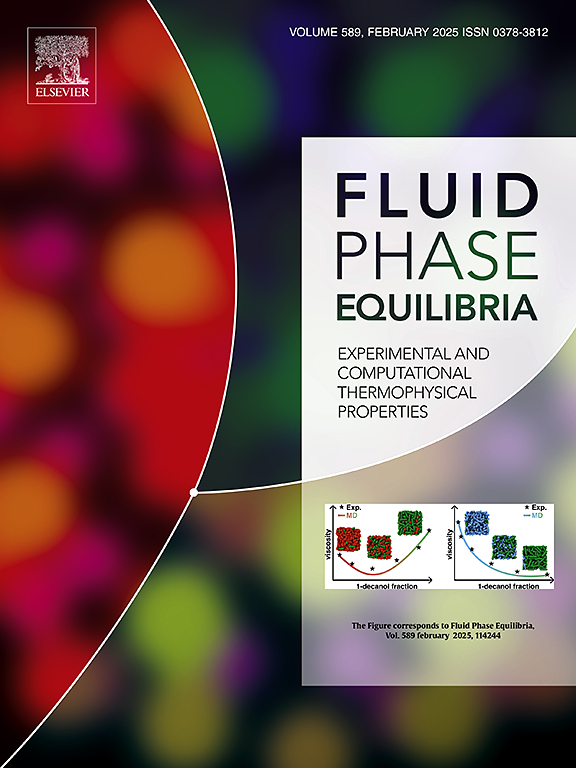Density measurements of homogeneous phase fluid mixtures comprising CO2/propanol and CO2/butanol binary systems and correlation with PC-SAFT equation of state
IF 2.8
3区 工程技术
Q3 CHEMISTRY, PHYSICAL
引用次数: 0
Abstract
Given that supercritical CO2–alcohol mixtures are often encountered in natural gas, oil, and petroleum industries, the properties of binary CO2/alcohol mixtures are essential for chemical process design, and their prediction is important. Equations of state (EoSs) are powerful tools for estimating physical properties and can be used to determine those of CO2/alcohol binary mixtures if molecular association is considered, i.e., the examination of the CO2–alcohol association from the EoS perspective improves property estimation. Herein, the densities of homogeneous phase fluid mixtures comprising CO2/1-propanol, CO2/2-propanol, and CO2/1-butanol binary systems, which are greatly affected by mixing, were measured using a high-pressure vibration-type density meter equipped with a circulation pump and variable-volume viewing cell. Homogeneity was ensured by observing the fluid through the viewing window of the variable-volume cell. Measurements were carried out at temperatures of 313–353 K, CO2 contents of 0–80 mol%, and pressures of up to 20 MPa, and the obtained data were correlated using the considering association between CO2 and alcohol-perturbed chain-statistical associating fluid theory (CACA-PC-SAFT) EoS. The mixture density correlation was affected by the estimation accuracy of the pure-alcohol density. Therefore, the pure-alcohol density was correlated using the PC-SAFT EoS, and the pure-alcohol parameters were determined. The mixture density was effectively correlated using the CACA-PC-SAFT EoS based on these parameters. Furthermore, we determined the dependence of the obtained mixing parameters on temperature and alcohol species, revealing that mixing parameters could be predicted by combining experimental or quantum chemical information on alcohols or CO2 and alcohols.

求助全文
约1分钟内获得全文
求助全文
来源期刊

Fluid Phase Equilibria
工程技术-工程:化工
CiteScore
5.30
自引率
15.40%
发文量
223
审稿时长
53 days
期刊介绍:
Fluid Phase Equilibria publishes high-quality papers dealing with experimental, theoretical, and applied research related to equilibrium and transport properties of fluids, solids, and interfaces. Subjects of interest include physical/phase and chemical equilibria; equilibrium and nonequilibrium thermophysical properties; fundamental thermodynamic relations; and stability. The systems central to the journal include pure substances and mixtures of organic and inorganic materials, including polymers, biochemicals, and surfactants with sufficient characterization of composition and purity for the results to be reproduced. Alloys are of interest only when thermodynamic studies are included, purely material studies will not be considered. In all cases, authors are expected to provide physical or chemical interpretations of the results.
Experimental research can include measurements under all conditions of temperature, pressure, and composition, including critical and supercritical. Measurements are to be associated with systems and conditions of fundamental or applied interest, and may not be only a collection of routine data, such as physical property or solubility measurements at limited pressures and temperatures close to ambient, or surfactant studies focussed strictly on micellisation or micelle structure. Papers reporting common data must be accompanied by new physical insights and/or contemporary or new theory or techniques.
 求助内容:
求助内容: 应助结果提醒方式:
应助结果提醒方式:


